Mr. Donald S Soloniuk M.D.
Neurosurgeon
324 5th St Suite 101 Lewiston ID, 83501About
Dr. Donald Soloniuk practices Neurological Surgery in Lewiston, ID. As a Neurological Surgeon, Dr. Soloniuk prevents, diagnoses, evaluates, and treats disorders of the autonomic, peripheral, and central nervous systems. Neurological Surgeons are trained to treat such disorders as spinal canal stenosis, herniated discs, tumors, fractures, and spinal deformities, among many others.
Education and Training
Loma Linda University School of Medicine 1980
Board Certification
Neurological SurgeryAmerican Board of Neurological SurgeryABNS
Provider Details
Expert Publications
Data provided by the National Library of Medicine- Differential inhibition of proliferation of human squamous cell carcinoma, gliosarcoma and embryonic fibroblast-like lung cells in culture by plant flavonoids.
- Use of allopurinol and deferoxamine in cellular protection during ischemia.
- Coaptation of the anterior rami of C-3 and C-4 to the upper trunk of the brachial plexus for cervical nerve root avulsion.
- Antiproliferative effects of citrus flavonoids on a human squamous cell carcinoma in vitro.
- Neurological injury and patterns of sacral fractures.
- Leukotrienes in experimental spinal cord injury.
- Rhinocerebral mucormycosis with extension to the posterior fossa: case report.
- Cerebellomedullary ganglioglioma: CT and MR findings.
- Ascorbic acid-enhanced antiproliferative effect of flavonoids on squamous cell carcinoma in vitro.
Treatments
- Herniated Disc
- Spinal Stenosis
- Degenerative Disc Disease (ddd)
Mr. Donald S Soloniuk M.D.'s Practice location
Dr. Sandra Lotstein, DO
324 5th St Suite 101 -Lewiston, ID 83501Get Direction
Mr. Donald S Soloniuk M.D.'s reviews
Write ReviewPatient Experience with Dr. Soloniuk
Recommended Articles
- What Is a Transorbital Lobotomy?
Transorbital LobotomyTransorbital lobotomy was once considered as a form of neurosurgery that was labeled as "insane". A pioneer in this field was a Portuguese doctor named António Egas Moniz. He introduced frontal lobotomy in 1935 for certain cases of psychosis and won a Nobel Prize because of...
- Scoliosis Pain: Treatment, Management, and Exercises
Scoliosis is a serious condition that often occurs more in females than in males. The condition itself can be hard to diagnose at the start, which is why the healthcare professional will subject the patient to several tests, including asking them to touch their toes as well as to find out if their...
- Are There Risks to a Spinal Stenosis Surgery?
Like any other surgical procedure, spinal stenosis surgery has its own risks and possible complications. However, if performed correctly by professional medical staff, the possibility of any complication after the surgery is low.The potential risks and possible complications following a spinal...
- What Is Oromandibular Dystonia?
Oromandibular DystoniaOromandibular dystonia is a type of focal dystonia. This condition is also called cranial dystonia, in which the face, jaw, or tongue forcefully contracts and becomes difficult to open and close the mouth. Thus, a person's speech and ability to chew are affected. Cranial...
- What to Expect in Laminectomy and Spinal Fusion
Decompressive laminectomy is done to release pressure exerted on the roots of the nerves found on the lower back. The condition is mostly brought by old age. There are, however, other reasons your surgeon may suggest surgery. These include herniated discs, traumas, and tumors. In case you are going...
- Recovery After a Laminectomy
Laminectomy is a surgical procedure done for the removal of the lamina, bone spurs, and ligaments that may be putting pressure on your spinal nerves and causing lower back pain. The procedure is said to be one of the most commonly performed back surgeries. Below is a detailed information on what...
Nearest Hospitals
TRI-STATE MEMORIAL HOSPITALl
1221 HIGHLAND AVENUE CLARKSTON WA 99403




